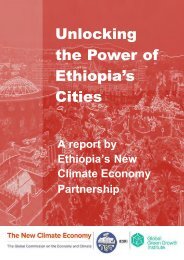EY-africa-attractiveness-survey-june-2015-final
EY-africa-attractiveness-survey-june-2015-final
EY-africa-attractiveness-survey-june-2015-final
You also want an ePaper? Increase the reach of your titles
YUMPU automatically turns print PDFs into web optimized ePapers that Google loves.
Reality FDI in Africa in 2014Three areas (Southern, East and West Africa) experiencedsubdued project inflows in 2014. That is because FDI in the keyhub countries of South Africa, Angola, Kenya, Nigeria and Ghanawas weaker than last year. But we believe these countries willremain important regional hubs for FDI in Africa, because thefactors drawing investors to them are stable and long-lasting.• Southern AfricaSouthern Africa attracts about one-third of FDI projects inAfrica, and their numbers have been growing at a compoundannual growth rate (CAGR) of 10.8% since 2007. This year,its inbound FDI projects fell 11.4%. Capital inflows more thandoubled to US$33.6b in 2014, thanks to a massive energy sectordeal, but there was a marked fall in FDI projects announced inSouth Africa. The region’s anchor economy netted 121 FDIprojects, down 17.7% on 2013. Although the country remainedAfrica’s FDI champion, the amount of investment and the numberof jobs created per project were more modest. South Africa’sproject lead narrowed for the first time since 2010. Companiesfrom both the US and the UK, South Africa’s largest investors,announced fewer projects in 2014, like those from Germany andSpain. Angola, another key Southern African FDI destination, alsoattracted fewer projects last year. FDI in the country has graduallytapered after peaking at 52 projects in 2009.• East AfricaSince 2007, FDI projects in East Africa have grown at a CAGRof 19.9%, the strongest in Africa. The region has also attractedgrowing FDI investment and jobs during this period, bolsteredby the success of regional integration. In 2014, the numberof jobs created by FDI in East Africa almost doubled, though itattracted 11.6% fewer projects. FDI into East Africa’s largesteconomy, Kenya, softened during 2014, after growing by morethan 30% a year (CAGR) since 2007. Though it captured 8.5% ofAfrican inflows in 2014, the average project was small, Kenya’sshare of investment was a mere 1.8% and of jobs created 2.4%.Investors from the UK and Japan, who were Kenya’s largestinvestors in 2013, started fewer projects in 2014. Other EastAfrican countries, including Uganda, Tanzania and Rwanda alsosecured fewer FDI projects. Ongoing security problems andconflicts in Kenya and South Sudan have proved to be a concern,but investors are likely to remain interested in the region. Marketopportunities, natural resources and accelerating regionalintegration will continue attracting FDI.• West AfricaWest Africa attracted 23.2% fewer FDI projects in 2014, thoughby capital, investment increased 21%. The shift to fewer, highervalue projects came after seven years during which projectnumbers rose at a CAGR of 19.5%, the second-highest growthrate in Africa. Capital investment increased by 14.3% during thesame period. However, investors were probably deterred fromlaunching projects in parts of West Africa by the outbreak of Ebolathat began in December 2013 in Guinea. According to the WorldBank, Ebola cost Guinea, Liberia and Sierra Leone US$500m in2014, and may cost an additional US$1.6b in <strong>2015</strong>. 12Nigeria, now Africa’s largest economy after rebasing its GDPlast year, attracted 49 FDI projects in 2014, 10 fewer thanduring 2013. However, the average project involved more thantwice as much investment, though job creation continued tolag. Companies from South Africa, the US, the UAE and Japanall launched fewer projects. Investment targeting Nigerianconsumers slackened: investors announced only six projects inCPR, down from 23 in 2013.This widespread trend to fewer, but higher value projects was alsodisplayed last year in Ghana, the second-largest West Africaneconomy, where growth in project numbers has averaged 34.1%since 2007. In 2014, the number of inward investment projectsfell to 39, from 58 in 2013, even as capital investment rose61.3%. Ghana slipped to seventh position in our project ranking,from fourth in 2013. Consumer-facing investments (includingTMT, financial services as well as CPR) fell out of favor. SouthAfrican, UK and Nigerian investors all became more cautiousabout launching projects in Ghana.12 “Sierra Leone and Liberia fight with Ebola perceptions,” fDi Intelligence website, www.fdiintelligence.com, accessed 16 February <strong>2015</strong>.14 <strong>EY</strong>’s <strong>attractiveness</strong> <strong>survey</strong> Africa <strong>2015</strong> Making choices



